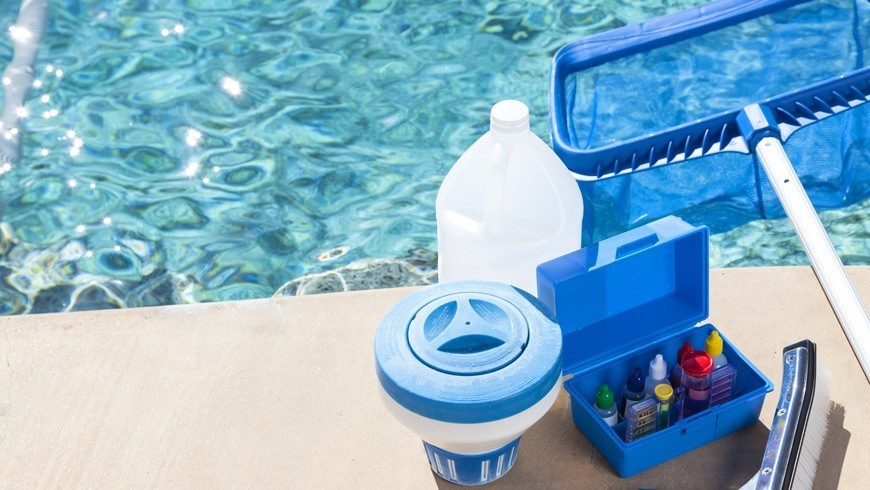
Many new pool owners have doubts about using chemicals and for a good reason. Having an above-ground swimming area in your backyard requires a lot of upkeep. Chemicals are the backbone of that maintenance. There are different supplies needed for keeping your pool in good condition. A significant part of these is chemicals.
You need a variety of these products to keep your swimming area safe and enjoyable all year round. The water inside it has specific chemistry. It contains substances that are responsible for optimal pH and alkalinity. For more information on the quality of water in swimming areas, see here.
Each chemical that is in the kit or you buy it separately has its purpose. Some of these products, like pool shocks, perform multiple functions, while others complement each other. You don’t need these products in stocks, as they are available and affordable for regular pool maintenance.
Water Cleansing Agents
The water in swimming areas requires control and balancing of the chemical factors in it. It’s the best way to ensure safe bathing and reduce potential health risks. The essential chemicals for regular maintenance are sanitizers. They serve to disinfect the water and remove any germs.
Chlorine is one of the more common sanitisers, and it’s responsible for killing bacteria and regulating pH levels. In general, it’s safe for use when the optimal level is between 1.0 and 3.0 parts per million (ppm). Test this parameter frequently, regardless of how you add chlorine to the water.
In higher amounts, chlorine can irritate the eyes and skin and even cause a rash. A small amount of this sanitizer will improve water consistency. But if it bothers you, try other chemicals like bromine or biguanide.
Importance of Shocking
Using pool shock is another way to add chlorine (and some other minerals) to the water. It will balance the free chlorine level, alkalinity, and pH value. It should be optimal so that harmful bacteria and algae don’t multiply.
Unlike the mere addition of chlorine, pool shocking has the purpose of raising the level of this mineral quickly and further improving the water chemistry. These products will remove everything that chlorine may not. You’re free to use a pool shock and sanitizer (preferably in tablets that dissolve slowly) at the same time.
On the next page, check more information about the importance of chlorine for the safety of the swimming area:
PH Level Adjusters

Not all of these sanitizers work well. Some are too harsh, and they leave a residue that builds up in the filter and eventually breaks it. Others won’t damage the pool equipment but can disturb pH levels and alkalinity. That can create additional issues within your swimming area.
Chlorine and bromine usually don’t have what it takes to achieve an optimal pH level between 7.4-7.6. So there are other products out there that neutralize the adverse effects of sanitizers on pH values. These are pH stabilizers (increasers and decreasers). Make sure you know what your pH level is before you buy anything.
Algaecides
Algae are nasty microbes that can form a slippery green layer on the pool surface. This greasy film is not harmful to your health but can irritate your eyes and skin. It can also cause other issues, including slower pump work and a shorter life span for filters.
The purpose of sanitizers is to neutralize algae so you can enjoy crystal clear, healthy water. Chlorine can help, but algae usually become resistant after a while. So you need something more powerful to get rid of these floating things. These are specialized products called algaecides.
You can find different types of algaecides in supplies stores, and they are all used to kill algae. Depending on the algae type (yellow, green, or black), you will find the proper treatment. Some pool supply companies even offer multipurpose algaecides that also kill bacteria and germs.
Opening and Closing Kits
Opening and closing a pool doesn’t just mean pulling or removing a cover. These processes are a bit more complex, as they need to involve certain chemicals that are supposed to affect water quality.
When closing the swimming area, you should prevent the deposition of algae during the winter. The pool pump will most likely not work, so you will need special winter algaecides. They’ll activate with the first warm days. Also, you’ll need antifreeze to prevent equipment and line freezing and expensive repairs.
The opening involves checking the quality of the water after cold days. Parameters to check are the chlorine content, pH level, alkalinity, and calcium hardness. Based on that, you will know which above ground swimming pool chemicals you need. Opening kits most commonly include pH and alkaline increasers, shock products for raising chlorine levels, as well as chemicals for treating stains.
To get the most of pool chemicals, you need to know what they do. Many people underestimate the potency of these products and take them for granted. Every mishandling can be risky. If you’re unsure what to do, talk with a pool professional for more information.










Recent Comments